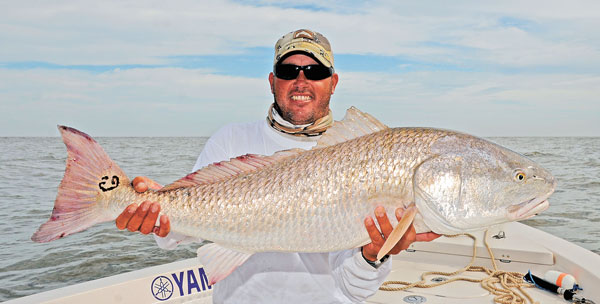
Learn how to get the most from a month of great action as big reds invade Bulls Bay sandbars.
Adam Paul remembers the day several years ago when he stumbled onto the fall fishery for big bull redfish at Bulls Bay.
It was late October, and Paul “discovered” that the sandbars and sloughs at the gaping mouth of the bay were full of feeding redfish — big fish heading back out to the ocean as the water cools off inside.
They were apparently ganged up along the shoals because their migration happened to cross paths with the millions of finger mullet making their fall migration down the beach to warmer water.
“We caught six big reds that day,” said Paul, a former Charleston charter captain who was the host of Gillznfinz, a fishing show televised the past several years on Versus and the World Fishing Network. “The smallest was 28 pounds, and the biggest was close to 50 pounds. We had a 52-inch fish.”
Paul took some mental notes, put two and two together and figured out what was going on, put the pattern into his memory banks, and nowadays, he tries to duplicate that big first day at least once or twice every year.
“That first time, it was Oct. 17 — I’ve got that down in my logbook,” Paul said. “Late October is perfect; the fish are there the last two weeks in October and the first two weeks in November.”
The deeper you get into November, the cooler the water gets, and the mullet push south and leave, and the reds pull out to the nearshore ocean structure where they spend the winter.
But for a month, the action is unmatched, and it’s not difficult to get in on it. You’re hunting down the right combination of tide, good bait, stout tackle and a strong back and forearms.
“What you’re looking for is a nice, incoming tide in the morning,” said Paul, who waited a year or two before sharing his discovery with Chris Wilson, a former Charleston-area guide who now works for Hells Bay Boats in Florida. Their half-day trip the first week of November produced nine bull reds — the largest a whisker away from the 50-inch mark. “We’re going to have a fair amount of tidal change out there. What you’re looking for is a sandbar that’s exposed at low tide, with the water lapping at it, maybe six to eight inches of water on it, just rolling over the bar.
“When the tide starts coming in, it will push water over the sand bar, and the reds will move up and feed down the bar,” he said. “Those fish will come across the bar with their backs out of the water.”
When the bull reds find a nice live finger mullet or a piece of fresh cut bait bouncing along the edge of the shoal, there’s little doubt about the ferociousness of the strike, as a big fish rips off line, making the drag scream on a big spinning reel loaded with 50-pound braid.
“The reds have come in to spawn, and they feed voraciously after the spawn,” Paul said. “What’s amazing is how big they are and how fast they are.”
On his trip with Wilson, Paul’s crew opened the morning with a 42-inch, 26-pound bull red that was feeding on the first sandbar they set up to fish. An hour or so later, with the tide rolling in, they moved across one deep slough to a sandbar closer inshore. It took no time for the action to heat up, and within another two hours, eight more bull reds were hooked and landed. The crew danced around two doubleheader hookups, the first a 35-inch fish and a 48-inch fish, the second a 35-inch fish and a 49-inch fish.
“The reds come running up on the shoals and eat the finger mullet, and you hope when you hook up that he comes out on the side with the deep water,” Paul said. “You want to hook him on the top of the sandbar where he’s feeding and fight him in deep water.
“The first hour of the incoming tide is usually the best. As the tide rolls in, you want to move closer to the beach. You want to sort of run the tide to sandbars that don’t have as much water on them.”
Paul likes to anchor up in the deeper water of the slough just offshore of the sandbar he’s targeting. He wants to be within “half a cast” of the bar, and he likes to put out five rods — three toward the top of the bar and two into slightly deeper water on the outside edge.
His terminal tackle is a rig that closely resembles what a surf fisherman might use when slinging casts off the beach for big reds. He clips a 3- or 4-inch pyramid sinker to a fish-finder rig, ties in a barrel swivel on one end of a fairly short piece of 40- to 50-pound fluorocarbon leader and ties a 6/0 circle hook to the other end. The bait of choice is a 4-inch finger mullet or fresh-cut mullet pieces.
“I’ve refined my game using a shorter and shorter leader,” Paul said. “A buddy of mind who is a guide in North Carolina, Greg Voliva, got me using a short leader. A flapper (ray) will get on top of it but won’t hit it.
“The other thing is, the more you fish into November, toward the end of the mullet run, there won’t be as many sharks to compete with.”
Paul said weather is no variable, other than Bulls Bay being shallow and more difficult to run in heavy seas. The reds and mullet will stay pretty much in the same areas, feeding whenever they find the right tidal conditions on the sandbars and shoals that line the entrance to the bay.
“It’s better to have a cool snap and for it to be a little chilly,” Paul said. “I like to take Santee Cut to get to Bulls Bay from Charleston, and after you’ve had a little cool weather, it feels like it’s time for football games and deer hunting. And it’s time to get out and fish for those big reds.”

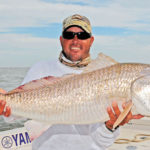
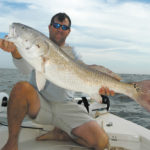
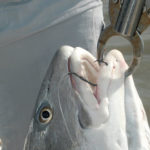
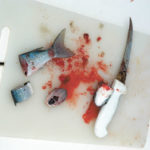
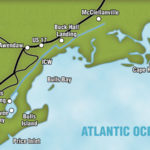
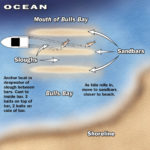
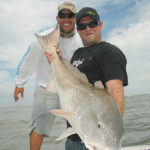
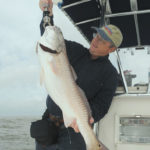



Be the first to comment